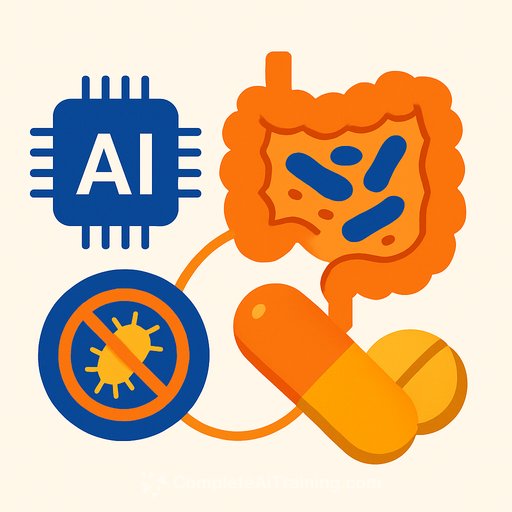AI finds a narrow-spectrum antimicrobial with real clinical potential
Algorithmic discovery is starting to matter for antibacterial R&D. Recent work points to deep learning models that can predict target engagement and prioritize candidates worth advancing.
That matters against a backdrop of antimicrobial resistance (AMR) projections that reach 10 million deaths per year by 2050. In 2021, an estimated 4.7 million deaths were associated with AMR and 1.14 million were directly attributed, underscoring the urgency.
Why this matters for AMR
Most clinically used antibiotics are broad-spectrum. They disrupt the gut microbiome and drive resistance because the same agents are used across many indications.
Targeted agents can reduce collateral damage and slow resistance. The challenge has been finding molecules with clear mechanisms and a safety profile that supports long-term use.
The study at a glance
Researchers at the MIT Jameel Clinic applied deep learning to predict antibiotic-protein target interactions and triage candidates that spare commensal gut bacteria. The approach is positioned to support patients with inflammatory bowel disease (IBD), including Crohn's disease, where microbiome preservation is critical.
As one scientist noted: "The problem isn't finding molecules that kill bacteria in a dish. A major hurdle is figuring out what those molecules actually do inside bacteria." Mechanistic clarity is the bridge from hits to therapies.
What they did
The team screened 10,747 bioactive small molecules against adherent-invasive E. coli (AIEC). They identified enterololin, a narrow-spectrum antibacterial with activity against Enterobacteriaceae (including E. coli and Salmonella).
Enterololin showed enhanced activity when combined with a subinhibitory concentration of SPR741, a polymyxin B analogue used here to increase outer membrane permeability in Gram-negative bacteria.
Mechanism and selectivity
Substructure analysis and deep learning-guided experiments indicate enterololin perturbs lipoprotein trafficking via the LolCDE transporter complex. This mechanism underpins its selectivity for Enterobacteriaceae.
In mice, enterololin demonstrated low mammalian cytotoxicity and largely preserved overall microbiome composition. That profile supports further development for indications where gut balance matters.
Why narrow-spectrum is a practical win
Narrow-spectrum activity can reduce selection pressure on non-target species and help stewardship. It also aligns with precision treatment strategies that focus on defined pathogen sets.
For GI indications, sparing beneficial microbes is more than a nice-to-have. It can reduce dysbiosis-related complications and improve long-term outcomes.
Implications for discovery teams
- Prioritize target-aware screening: integrate binding-prediction models early to focus on candidates with plausible mechanisms.
- Confirm mechanism fast: combine deep learning hypotheses with orthogonal assays to validate targets such as LolCDE.
- Engineer permeability: pair narrow-spectrum agents with permeabilizers (for Gram-negatives) to overcome intrinsic barriers.
- Add microbiome endpoints: include community composition and functional readouts alongside MIC and kill curves.
- Plan translation: bring PK/PD, resistance frequency, and safety pharmacology forward to de-risk first-in-human studies.
What to watch next
Structure-activity optimization around enterololin for potency, permeability, and metabolic stability. Combination dosing strategies with SPR741 or similar adjuvants.
Resistance mapping against LolCDE pathway perturbation, and potential off-target effects in mammalian systems. Clinical positioning for IBD-associated infections where narrow coverage is an advantage.
Source and further reading
The work was reported in Nature as "Discovery and artificial intelligence-guided mechanistic elucidation of a narrow-spectrum antibiotic," and builds on ongoing efforts at the MIT Jameel Clinic. For broader AMR context, see Nature's coverage of antimicrobial resistance research.
Upskill for AI-driven discovery
If you are building ML pipelines for target prediction, dataset curation, or active learning in drug discovery, explore focused training options: Latest AI courses.
Your membership also unlocks:






